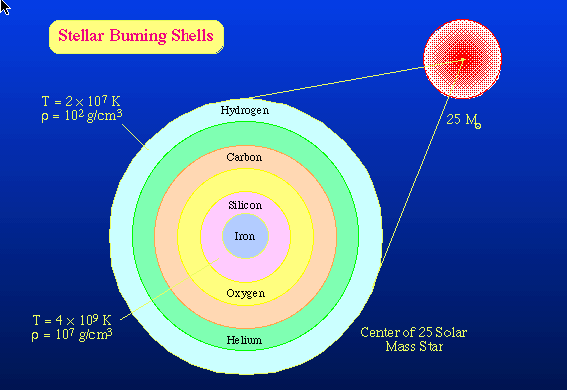Tale of a Supernova
Part of the Crab Nebula lab.

A star having a mass greater than 6 times that of our Sun lives a fast and furious life. Hydrogen fusion in the core shifts to helium fusion (He to C). Then carbon fusion (C to O), on through oxygen (O to Ne), neon (Ne to Mg), magnesium (Mg to Si), and finally silicon fusion (Si to Fe) takes place. Each change in fusion in the core is accompanied by a corresponding change in shell-burning. Each step takes a shorter period of time until only a tiny core of iron ash remains. Nuclear burning of iron and heavier elements absorbs energy, rather than producing it. The source of the radiative pressure that supported the star against gravity for its millions-of-years lifetime disappears. Even though the interior of the star has a temperature of billions of degrees Kelvin, the force of gravity overwhelms the pressure and the star collapses.
Within seconds, the entire star implodes. The core temperature rises to nearly 10 billion K. At these temperatures, individual photons have energies high enough to split iron into lighter nuclei and then to break those lighter nuclei apart until only protons and neutrons remain. This is called photo-disintegration (disintegration by light). In less than a second, the collapsing core undoes all the nuclear fusion that occurred during the previous 10 million years! Splitting nuclei into smaller pieces requires a lot of energy. So the core cools and the pressure falls. Gravity becomes even more important. As nuclei are destroyed, the core of the star becomes even less able to support itself against its own gravity. The collapse accelerates.
Eventually, (in less than a second!), the core consists entirely of simple elementary particles: electrons, protons, neutrons, and photons at enormously high densities. The core continues to shrink. As the core density continues to rise, the protons and electrons are crushed together, forming neutrons and neutrinos. Most of the neutrinos produced pass through the core and out into space, carrying away even more energy as they go, cooling the core and reducing the pressure.
Gravity becomes even more important. There is nothing to prevent the core from collapsing until the neutrons come into contact with one another. As with degenerate electrons, there is a limit to how closely neutrons can be packed. The pressure from neutron degeneracy opposes gravity, but not until the core has overshot its point of equilibrium. The dense core bounces back with a vengeance. An enormously energetic shock wave sweeps through the star at high speed, blasting all the overlying layers into space. In the process, the shock wave forces neutrons into the nuclei of the elements produces outside of the core, building up progressively heavier and heavier elements. No longer does this process stop at iron. In the wake of the shock wave we find some of the most massive atoms: gold, silver, lead, mercury, uranium. The star finally explodes. For a period of a few days the exploding star may rival in brightness the entire galaxy in which it resides: we witness a supernova!